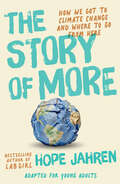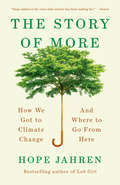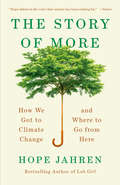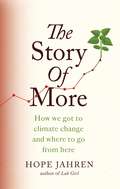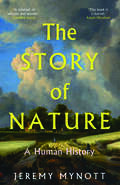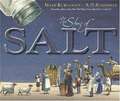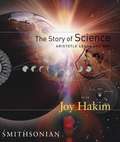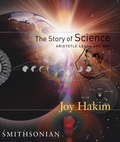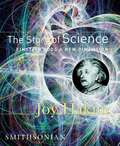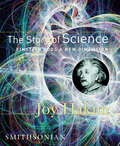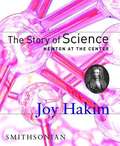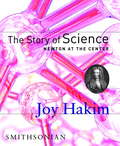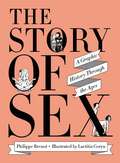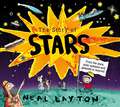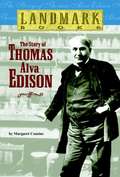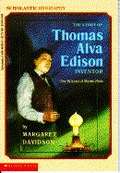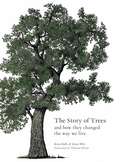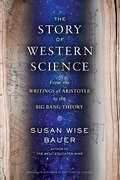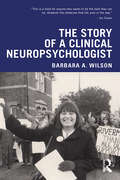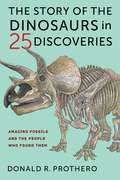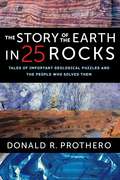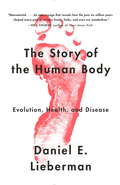- Table View
- List View
The Story of More (Adapted for Young Adults): How We Got to Climate Change and Where to Go from Here
by Hope JahrenThis young adult adaptation of acclaimed geochemist and geobiologist Hope Jahren's highly respected nonfiction work is the perfect book for those interested in learning about climate change and how they can contribute to creating a more sustainable future.Hope Jahren, acclaimed geochemist and geobiologist, details the science behind key inventions, clarifying how electricity, large-scale farming, and automobiles have both helped and harmed our world. Jahren explains the current and projected consequences of unchecked global warming, from superstorms to rising sea levels, resulting from the unprecedented amounts of greenhouse gases being released into our atmosphere. The links between human consumption habits and our endangered existence are very real, with consequences leading to a crossroads of survival and extinction. Still, Jahren maintains that our ever-broadening science-based knowledge can help us counter this dilemma. The eye-opening information provided in The Story of More will help readers understand the path we must take. If we collectively make informed choices now, Jahren reassures us, our future can be as bright as we imagine it can be.
The Story of More: How We Got to Climate Change and Where to Go from Here
by Hope JahrenFrom the bestselling author of Lab Girl comes a slim, urgent missive on the defining issue of our time: here is Hope Jahren on climate change, our timeless pursuit of more, and how the same human ambition that got us here can also be our salvation.Hope Jahren is an award-winning geobiologist, a brilliant writer, and one of the seven billion people with whom we share this earth. The Story of More is her impassioned open letter to humanity as we stand at the crossroads of survival and extinction. Jahren celebrates the long history of our enterprising spirit--which has tamed wild crops, cured diseases, and sent us to the moon--but also shows how that spirit has created excesses that are quickly warming our planet to dangerous levels. In short, highly readable chapters, she takes us through the science behind the key inventions--from electric power to large-scale farming and automobiles--that, even as they help us, release untenable amounts of carbon dioxide into the atmosphere. She explains the current and projected consequences of greenhouse gases--from superstorms to rising sea levels--and shares the science-based tools that could help us fight back. At once an explainer on the mechanisms of warming and a capsule history of human development, The Story of More illuminates the link between our consumption habits and our endangered earth. It is the essential pocket primer on climate change that will leave an indelible impact on everyone who reads it.
The Story of More: How We Got to Climate Change and Where to Go from Here
by Hope Jahren&“Hope Jahren is the voice that science has been waiting for.&” —Nature &“A superb account of the deadly struggle between humanity and what may prove the only life-bearing planet within ten light years, written in a brilliantly sardonic and conversational style.&” —E. O. Wilson&“Hope Jahren asks the central question of our time: how can we learn to live on a finite planet? The Story of More is thoughtful, informative, and—above all—essential.&” —Elizabeth Kolbert, author of The Sixth ExtinctionHope Jahren is an award-winning scientist, a brilliant writer, a passionate teacher, and one of the seven billion people with whom we share this earth. In The Story of More, she illuminates the link between human habits and our imperiled planet. In concise, highly readable chapters, she takes us through the science behind the key inventions—from electric power to large-scale farming to automobiles—that, even as they help us, release greenhouse gases into the atmosphere like never before. She explains the current and projected consequences of global warming—from superstorms to rising sea levels—and the actions that we all can take to fight back. At once an explainer on the mechanisms of global change and a lively, personal narrative given to us in Jahren&’s inimitable voice, The Story of More is the essential pocket primer on climate change that will leave an indelible impact on everyone who reads it.
The Story of More: How We Got to Climate Change and Where to Go from Here
by Hope Jahren'Hope Jahren asks the central question of our time: how can we learn to live on a finite planet? The Story of More is thoughtful, informative and - above all - essential' Elizabeth Kolbert, author of The Sixth ExtinctionHope Jahren is an award-winning geobiologist, a brilliant writer, an inspiring teacher, and one of the seven billion people with whom we share this earth. In The Story of More, Jahren illuminates the link between human consumption habits and our imperiled planet. In short, highly readable chapters, she takes us through the science behind the key inventions - from electric power to large-scale farming and automobiles - that, even as they help us, release untenable amounts of carbon dioxide into the atmosphere. She explains the current and projected consequences of greenhouse gases - from superstorms to rising sea levels - and the actions that all of us can take to fight back. At once an explainer on the mechanisms of warming and a lively, personal narrative given to us in Jahren's inimitable voice, The Story of More is the essential pocket primer on climate change that will leave an indelible impact on everyone who reads it.
The Story of Nature: A Human History
by Jeremy MynottThe story of humanity&’s evolving relationship with the natural world from pre-history to the present day Nature has long been the source of human curiosity and wonderment, and the inspiration for some of our deepest creative impulses. But we are now witnessing its rapid impoverishment, even destruction, in much of our world. In this beautifully illustrated book, Jeremy Mynott traces the story of nature—past, present, and future. From the dramatic depictions of animals by the prehistoric cave-painters, through the romantic discovery of landscape in the eighteenth century, to the climate emergency of the present day, Mynott looks at the different ways in which humankind has understood the world around it. Charting how our ideas about nature emerged and changed over time, he reveals how the impulse to control nature has deep historical roots. As we reach an environmental crisis point, this vital study shows how human imagination and wonder can play a restorative role—and reveal what nature ultimately means to us.
The Story of Rosy Dock
by Jeannie BakerThe plant rosy dock is not native to Australia. A newcomer who settled in the desert area of central Australia planted it in her garden. After each rare period of rain the desert blossoms, and over the years the seeds of this plant have blown their way across south, central and western Australia. Full-color collage illustrations.
The Story of Salt
by Mark KurlanskyThe book shows both the scientific and historical ways that salt has shaped the world.
The Story of Science: Aristotle Leads the Way
by Joy HakimReaders will travel back in time to ancient Babylonia, Egypt, and Greece. They will meet the world's first astronomers, mathematicians, and physicists and explore the lives and ideas of such famous people as Pythagoras, Archimedes, Brahmagupta, al-Khwarizmi, Fibonacci, Ptolemy, St. Augustine, and St. Thomas Aquinas. Hakim will introduce them to Aristotle--one of the greatest philosophers of all time--whose scientific ideas dominated much of the world for eighteen centuries. In the three-book The Story of Science series, master storyteller Joy Hakim narrates the evolution of scientific thought from ancient times to the present. With lively, character-driven narrative, Hakim spotlights the achievements of some of the world's greatest scientists and encourages a similiar spirit of inquiry in readers. The books include hundreds of color photographs, charts, maps, and diagrams; informative sidebars; suggestions for further reading; and excerpts from the writings of great scientists.
The Story of Science: Aristotle Leads the Way
by Joy HakimReaders will travel back in time to ancient Babylonia, Egypt, and Greece. They will meet the world's first astronomers, mathematicians, and physicists and explore the lives and ideas of such famous people as Pythagoras, Archimedes, Brahmagupta, al-Khwarizmi, Fibonacci, Ptolemy, St. Augustine, and St. Thomas Aquinas. Hakim will introduce them to Aristotle--one of the greatest philosophers of all time--whose scientific ideas dominated much of the world for eighteen centuries.In the three-book The Story of Science series, master storyteller Joy Hakim narrates the evolution of scientific thought from ancient times to the present. With lively, character-driven narrative, Hakim spotlights the achievements of some of the world's greatest scientists and encourages a similiar spirit of inquiry in readers. The books include hundreds of color photographs, charts, maps, and diagrams; informative sidebars; suggestions for further reading; and excerpts from the writings of great scientists.
The Story of Science: Einstein Adds a New Dimension
by Joy HakimIn volume three, students will look over Albert Einstein's shoulder as he and his colleagues develop a new kind of physics. It leads in two directions: to knowledge of the vast universe and its future (insights build on Einstein's theories of relativity), and to an understanding of the astonishingly small subatomic world (the realm of quantum physics). Students will learn why relativity and quantum theory revolutionized our world and led to the most important ideas in modern science, maybe of all time. In the three-book The Story of Science series, master storyteller Joy Hakim narrates the evolution of scientific thought from ancient times to the present. With lively, character-driven narrative, Hakim spotlights the achievements of some of the world's greatest scientists and encourages a similiar spirit of inquiry in readers. The books include hundreds of color photographs, charts, maps, and diagrams; informative sidebars; suggestions for further reading; and excerpts from the writings of great scientists.
The Story of Science: Einstein Adds a New Dimension
by Joy HakimIn volume three, students will look over Albert Einstein's shoulder as he and his colleagues develop a new kind of physics. It leads in two directions: to knowledge of the vast universe and its future (insights build on Einstein's theories of relativity), and to an understanding of the astonishingly small subatomic world (the realm of quantum physics). Students will learn why relativity and quantum theory revolutionized our world and led to the most important ideas in modern science, maybe of all time.In the three-book The Story of Science series, master storyteller Joy Hakim narrates the evolution of scientific thought from ancient times to the present. With lively, character-driven narrative, Hakim spotlights the achievements of some of the world's greatest scientists and encourages a similiar spirit of inquiry in readers. The books include hundreds of color photographs, charts, maps, and diagrams; informative sidebars; suggestions for further reading; and excerpts from the writings of great scientists.
The Story of Science: Newton at the Center
by Joy HakimRead this book and you'll know more science than Isaac Newton did. And since Newton was one of the smartest humans ever, that's saying something. Like all good scientists, Newton understood that he was involved in a quest that can never be finished. He knew that his work would get trimmed and topped. Artists and literary figures don't think like that. No one wants to change or add to Shakespeare. But science keeps building, and when new blocks are put in place, that often means throwing out the old or adapting it before heading on--to new heights. So there's nothing dull or static about science's story. It's a tale of exploration, one that will stretch your mind to its limits. [This text is listed as an example that meets Common Core Standards in English language arts in grades 9-10 at http://www.corestandards.org.]
The Story of Science: Newton at the Center
by Joy HakimIn volume two, students will watch as Copernicus's systematic observations place the sun at the center of our universe--to the dismay of establishment thinkers. After students follow the achievements and frustrations of Galileo, Kepler, and Descartes, they will appreciate the amazing Isaac Newton, whose discoveries about gravity, motion, colors, calculus, and Earth's place in the universe set the stage for modern physics, astronomy, mathematics, and chemistry.In the three-book The Story of Science series, master storyteller Joy Hakim narrates the evolution of scientific thought from ancient times to the present. With lively, character-driven narrative, Hakim spotlights the achievements of some of the world's greatest scientists and encourages a similiar spirit of inquiry in readers. The books include hundreds of color photographs, charts, maps, and diagrams; informative sidebars; suggestions for further reading; and excerpts from the writings of great scientists.
The Story of Sex: A Graphic History Through the Ages
by Philippe Brenot Laetitia Coryn Will McmorranThe first graphic history of sex chronicles sexuality and human intimacy through the ages, from our primate pasts to our robotic futures.Humans have had sex on the brain since pre-civilization either for pleasure, power, revenge, a desire for children, or simply because it isn't allowed. Today, sex is all around us but it's rarely explained and almost never taught. In The Story of Sex, sexologist Phillipe Brenot combines anthropology, sociology, psychology and history with witty comics by Latetita Coryn for an in-depth explanation of this essential aspect of humanity. Organized chronologically into sections like Babylon: Free Love, The Middle Ages: Heaven and Hell, and The 20th Century: Sexual Liberation, Brenot explores what eroticism really is, how our ancestors behaved sexually, when the first couple was established, how superstition and morality laws shaped sexuality, the use of pornography in the digital age, and how some ancient civilizations were far ahead of their time when it came to gender equality.Full of fascinating details like Cleopatra's invention of the vibrator and a Dutch shopkeeper's accidental discovery of the existence of sperm--all accompanied by hilarious comics and dialogue--The Story of Sex is informative, unique, and entertaining book.
The Story of Stars
by Neal LaytonEach night as the sun goes down and the sky grows dark, STARS come out. But what are stars? Where are they? And what role have they played throughout history?Over thousands of years humans have gazed up curiously at the stars, wondering why the sky looks the way it does. Step back in time and see how these theories have changed over the years, and what we now know about these sparkling celestial objects. From the stars, to solar systems to galaxies and beyond, this bold and funny book from Neal Layton tells you everything you've ever wanted to know about the night sky.
The Story of Thomas Alva Edison
by Margaret CousinsA biography of the great inventor whose creations have contributed to the comfort, convenience, and entertainment of people all over the world.
The Story of Thomas Alva Edison, Inventor: The Wizard of Menlo Park
by Margaret DavidsonAn accessible biography that explains the basic scientific principles behind Edison's discoveries as well as his joys, tragedies, and amazing successes.
The Story of Trees
by Kevin;West David“Wonderful stories and in-depth information you will normally never find in books about trees.†Piet Oudolf, Landscape Designer and creator of the planting design for New York’s High Line“Entwining fascinating facts about 100 trees with inspiring stories of their importance to ancient civilizations, trade, religious and pagan beliefs, wellbeing and medicinal uses over the ages, this delightful and well-researched book provokes curiosity on every page.†Dr. Alexandra Wagstaffe, Eden Project LearningThe Story of Trees takes the reader on a visual journey from some of the earliest known tree species on our planet to the latest fruit cultivars.The chosen trees have all had a profound effect on the planet and humankind. Starting with the Ginkgo biloba, fossils of which date back 270 million years, we learn about how trees came to be integral to the development of our species, and how specific trees have become important religious, political, and cultural symbols.With beautiful illustrations by Thibaud Herem and fascinating botanical facts and figures, this book will appeal to tree lovers from all over the world. “Within these pages, we hope to inform and inspire those who already have a love of trees, as well as those who otherwise may have taken them for granted. The Story of Treesis our story, but also that of our ancestors. It is about our relationship with some of the world’s most important trees, both on a local scale and globally. With so many trees to choose from, we have endeavored to feature those that have been, and in most cases continue to be, of cultural and practical value to humankind.†-From the Introduction of The Story of Trees
The Story of Trees: And How They Changed the Way We Live
by David West Kevin Hobbs“Wonderful stories and in-depth information you will normally never find in books about trees.”Piet Oudolf, Landscape Designer and creator of the planting design for New York’s High Line“Entwining fascinating facts about 100 trees with inspiring stories of their importance to ancient civilizations, trade, religious and pagan beliefs, wellbeing and medicinal uses over the ages, this delightful and well-researched book provokes curiosity on every page.”Dr. Alexandra Wagstaffe, Eden Project LearningThe Story of Trees takes the reader on a visual journey from some of the earliest known tree species on our planet to the latest fruit cultivars.The chosen trees have all had a profound effect on the planet and humankind. Starting with the Ginkgo biloba, fossils of which date back 270 million years, we learn about how trees came to be integral to the development of our species, and how specific trees have become important religious, political, and cultural symbols.With beautiful illustrations by Thibaud Herem and fascinating botanical facts and figures, this book will appeal to tree lovers from all over the world. “Within these pages, we hope to inform and inspire those who already have a love of trees, as well as those who otherwise may have taken them for granted. The Story of Treesis our story, but also that of our ancestors. It is about our relationship with some of the world’s most important trees, both on a local scale and globally. With so many trees to choose from, we have endeavored to feature those that have been, and in most cases continue to be, of cultural and practical value to humankind.”-From the Introduction of The Story of Trees
The Story of Water: A Moving Adventure (Into Reading, Level P #57)
by Diane BairNIMAC-sourced textbook <p><p> There is a lot to learn about water! This book tells you all about it, including how important it is for life on Earth. You'll learn about water contamination and how we can all help save this precious resource.
The Story of Western Science: From the Writings of Aristotle to the Big Bang Theory
by Susan Wise BauerA riveting road map to the development of modern scientific thought. In the tradition of her perennial bestseller The Well-Educated Mind, Susan Wise Bauer delivers an accessible, entertaining, and illuminating springboard into the scientific education you never had. Far too often, public discussion of science is carried out by journalists, voters, and politicians who have received their science secondhand. The Story of Western Science shows us the joy and importance of reading groundbreaking science writing for ourselves and guides us back to the masterpieces that have changed the way we think about our world, our cosmos, and ourselves. Able to be referenced individually, or read together as the narrative of Western scientific development, the book's twenty-eight succinct chapters lead readers from the first science texts by Hippocrates, Plato, and Aristotle through twentieth-century classics in biology, physics, and cosmology. The Story of Western Science illuminates everything from mankind's earliest inquiries to the butterfly effect, from the birth of the scientific method to the rise of earth science and the flowering of modern biology. Each chapter recommends one or more classic books and provides entertaining accounts of crucial contributions to science, vivid sketches of the scientist-writers, and clear explanations of the mechanics underlying each concept. The Story of Western Science reveals science to be a dramatic undertaking practiced by some of history's most memorable characters. It reminds us that scientific inquiry is a human pursuit--an essential, often deeply personal, sometimes flawed, frequently brilliant way of understanding the world. The Story of Western Science is an "entertaining and unique synthesis" (Times Higher Education), a "fluidly written" narrative that "celebrates the inexorable force of human curiosity" (Wall Street Journal), and a "bright, informative resource for readers seeking to understand science through the eyes of the men and women who shaped its history" (Kirkus). Previously published as The Story of Science.
The Story of a Clinical Neuropsychologist
by Barbara A. WilsonFrom a disadvantaged childhood to becoming one of our best-loved clinical neuropsychologists, this exceptional book tells the life story of Barbara A. Wilson, who has changed the way we think about brain injury rehabilitation. Barbara’s story shows how it is possible to have a fulfilling career alongside a successful family life, even when faced with the deepest of personal tragedies; the death of her adult daughter Sarah. Clinical and neuropsychologists will recognise Barbara’s influence on rehabilitation practice and her tireless aim to get what is best for people needing neuropsychological rehabilitation. It will inspire those with brain injury and their families who may struggle to make life meaningful, as well as encourage readers to stick to their beliefs and triumph in the face of obstacles.
The Story of the Dinosaurs in 25 Discoveries: Amazing Fossils and the People Who Found Them
by Donald R. ProtheroToday, any kid can rattle off the names of dozens of dinosaurs. But it took centuries of scientific effort—and a lot of luck—to discover and establish the diversity of dinosaur species we now know. How did we learn that Triceratops had three horns? Why don’t many paleontologists consider Brontosaurus a valid species? What convinced scientists that modern birds are relatives of ancient Velociraptor?In The Story of the Dinosaurs in 25 Discoveries, Donald R. Prothero tells the fascinating stories behind the most important fossil finds and the intrepid researchers who unearthed them. In twenty-five vivid vignettes, he weaves together dramatic tales of dinosaur discoveries with what modern science now knows about the species to which they belong. Prothero takes us from eighteenth-century sightings of colossal bones taken for biblical giants through recent discoveries of enormous predators even larger than Tyrannosaurus. He recounts the escapades of the larger-than-life personalities who made modern paleontology, including scientific rivalries like the nineteenth-century “Bone Wars.” Prothero also details how to draw the boundaries between species and explores debates such as whether dinosaurs had feathers, explaining the findings that settled them or keep them going. Throughout, he offers a clear and rigorous look at what paleontologists consider sound interpretation of evidence. An essential read for any dinosaur lover, this book teaches us to see an ancient world ruled by giant majestic creatures anew.
The Story of the Earth in 25 Rocks: Tales of Important Geological Puzzles and the People Who Solved Them
by Donald R. ProtheroEvery rock is a tangible trace of the earth’s past. The Story of the Earth in 25 Rocks tells the fascinating stories behind the discoveries that shook the foundations of geology. In twenty-five chapters—each about a particular rock, outcrop, or geologic phenomenon—Donald R. Prothero recounts the scientific detective work that shaped our understanding of geology, from the unearthing of exemplary specimens to tectonic shifts in how we view the inner workings of our planet. Prothero follows in the footsteps of the scientists who asked—and answered—geology’s biggest questions: How do we know how old the earth is? What happened to the supercontinent Pangea? How did ocean rocks end up at the top of Mount Everest? What can we learn about our planet from meteorites and moon rocks? He answers these questions through expertly chosen case studies, such as Pliny the Younger’s firsthand account of the eruption of Vesuvius; the granite outcrops that led a Scottish scientist to theorize that the landscapes he witnessed were far older than Noah’s Flood; the salt and gypsum deposits under the Mediterranean Sea that indicate that it was once a desert; and how trying to date the age of meteorites revealed the dangers of lead poisoning. Each of these breakthroughs filled in a piece of the greater puzzle that is the earth, with scientific discoveries dovetailing with each other to offer an increasingly coherent image of the geologic past. Summarizing a wealth of information in an entertaining, approachable style, The Story of the Earth in 25 Rocks is essential reading for the armchair geologist, the rock hound, and all who are curious about the earth beneath their feet.
The Story of the Human Body
by Daniel LiebermanIn this landmark book of popular science, Daniel E. Lieberman--chair of the department of human evolutionary biology at Harvard University and a leader in the field--gives us a lucid and engaging account of how the human body evolved over millions of years, even as it shows how the increasing disparity between the jumble of adaptations in our Stone Age bodies and advancements in the modern world is occasioning this paradox: greater longevity but increased chronic disease. The Story of the Human Body brilliantly illuminates as never before the major transformations that contributed key adaptations to the body: the rise of bipedalism; the shift to a non-fruit-based diet; the advent of hunting and gathering, leading to our superlative endurance athleticism; the development of a very large brain; and the incipience of cultural proficiencies. Lieberman also elucidates how cultural evolution differs from biological evolution, and how our bodies were further transformed during the Agricultural and Industrial Revolutions. While these ongoing changes have brought about many benefits, they have also created conditions to which our bodies are not entirely adapted, Lieberman argues, resulting in the growing incidence of obesity and new but avoidable diseases, such as type 2 diabetes. Lieberman proposes that many of these chronic illnesses persist and in some cases are intensifying because of "dysevolution," a pernicious dynamic whereby only the symptoms rather than the causes of these maladies are treated. And finally--provocatively--he advocates the use of evolutionary information to help nudge, push, and sometimes even compel us to create a more salubrious environment. (With charts and line drawings throughout.)
